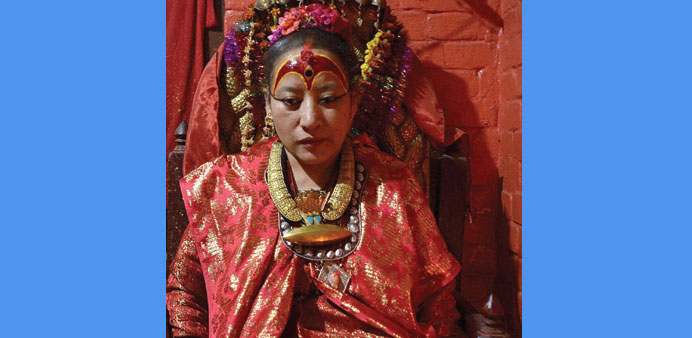Dhana Kumari Bajracharya, the longest reigning Kumari of Nepal, sits in her quarters in Kathmandu.
AFP/Kathmandu
When a massive earthquake struck Nepal in April, Nepal’s longest-serving “living goddess” or Kumari was forced to do the unthinkable — walk the streets for the first time in her life, she told AFP in a rare interview.
Still following the cloistered lifestyle she entered at the age of two, Dhana Kumari Bajracharya also opened up about her unusually long 30-year reign, suggesting the pain of her unceremonious dethroning in the 1980s was still raw.
Before the 7.9 magnitude April 25 quake, Bajracharya had only ever appeared in public while being carried in an ornate wooden palanquin.
The Himalayan nation’s Kumaris, live in seclusion and rarely speak in public, bound by customs that combine elements of Hinduism and Buddhism.
But as the tremor hit, shaking the ground, reducing buildings to rubble and killing thousands, Bajracharya left her quarters in the historic city of Patan, south of Kathmandu, for the first time in three decades. And for the first time on foot.
“I had never thought about leaving the house like that,” she said, clearly still traumatised by the disaster that claimed more than 8,800 lives.
“Perhaps the gods are angry because people don’t respect traditions as much anymore,” Bajracharya, 63, added.
As the disaster ripped through Nepal, shaking Bajracharya’s five-storey home, her family stayed indoors, waiting to see if the retired Kumari would break tradition and walk out with them.
“We couldn’t just leave the house like everyone else, we had to think of her. We didn’t know what to do,” said her niece, Chanira Bajracharya.
“But when nature forces you, you do the unthinkable,” she added. Dhana Kumari Bajracharya was enthroned in 1954 when she was just two years old and reigned for three decades as the Kumari of Patan.
The Kumari, a pre-pubescent girl from the Newar community, is considered an embodiment of the Hindu goddess Taleju.
Selection criteria are strict and include a number of specific physical attributes from an unblemished body to a chest like a lion and thighs like a deer.
Unlike Kathmandu’s “living goddess” who must move to an official residence, the Patan Kumari is allowed to live with her family.
“I loved going out during the festivals the most,” said Bajracharya, remembering how devotees lined up along Patan’s narrow streets, eager to receive her blessings.
The Patan Kumari is traditionally dethroned once she begins to menstruate and, since Bajracharya never started her periods, she continued to serve well into her thirties.
But in 1984, Nepal’s then crown prince Dipendra, who would go on to massacre his family 17 years later, stirred up a controversy which eventually ended her tenure.
“Why is she so old?” the 13-year-old prince reportedly asked when he saw Bajracharya during a festival, prompting priests to replace her with a young girl.
Thirty years later, the memory of her abrupt dismissal still stings. “They had no reason to replace me,” she said. “I was a little angry.”
Forced into retirement, Bajracharya decided to continue living the life she had always known, unable to abandon her duties or end her withdrawal from the outside world.
Every morning she wakes up, drapes an embroidered red skirt like the one she wore during her years as a Kumari, scrapes her hair into a topknot and lines her eyes with kohl curving upwards to her temples.
On special occasions, she uses red and yellow powder to draw a third eye in the middle of her forehead and takes to a wooden throne decorated with brass snake carvings.
Devotees are received, as when she was an official Kumari, on Saturdays and during festivals in a separate room in her red brick home reached by narrow stairs above two floors rented out to a shop and financial co-operative.
“The priests did what they had to do, but I cannot abandon my responsibilities,” she said.
When Bajracharya’s niece Chanira was chosen as a Kumari in 2001, she guided her through the process. Since the quake, however, she spends most of her time engrossed in prayer, according to Chanira.



